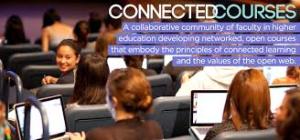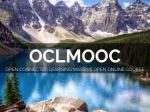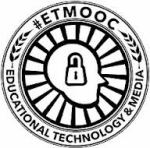Mimi Ito, Vera Michalchik, and Bill Penuel take us into the wonderfully intriguing deep end of the Connected Learning swimming pool in the latest Connected Courses MOOC (#ccourses) session, as anyone who attended the live version or catches it through the archived recording can confirm. And that’s a great thing since the deep end of any body of water is often where we find the interesting signs of life.
Continuing the massive open online course’s current two-week exploration of what drives the learning process (“Why We Need a Why”), the three educators interact with their online learners by exploring connections between learning (particularly connected learning), learning assessments, and learning outcomes.
This is far from the usual review of how well learners do within the confines of an explicitly defined learning experience—a semester-long course or, by extension, the sort of workplace learning and performance (staff training) offering that so many of us as trainer-teacher-learners provide and then review through a formal assessment process. It’s a connected-learning session that takes us into the outer reaches of models like Donald Kirkpatrick’s four levels of learning, where the gold standard is to ask what impact the learning eventually has not only on the learner, but on the community the learner ultimately serves. And it encourages us to take the learner’s point of view into account rather than focusing solely on the learning facilitator’s or learning organization’s vantage point.
“When you look from the perspective of the learner…the learning ecosystem looks very different than when you’re looking from the perspective of the class,” Ito reminds us during the session; it requires that we are as cognizant of what the learners bring to the learning space as we are of our own approach to facilitating the learning process—thinking about the learners “and how our practices in the classroom connect back out.”
“We want to take a long view of the outcomes,” Penuel suggests. “Do kids get to where they want to go next?…Where did this class lead them?”—questions we should just as firmly be asking within any training-teaching-learning setting.
All three presenters lead us into the deeper, far more significant question: Do we follow up with our learners to see “whether learning made a difference in their lives?”
“We have so few tools and practices that enable us to know what happened to students over time…a lot of these outcomes play out over time…you don’t really know what happens a few years down the line because nobody actually studies that,” Ito says.
 But the picture is not completely bleak, she adds. A Gallup-Purdue University study released in May 2014 and designed to document post-graduation levels of workplace engagement and overall “well-being” provides some guidance for learning facilitators seeking ways to provide long-term positive benefits through their efforts. Learning that was project-based and that provided meaningful connections between the learners and those facilitating their learning led to significantly higher levels of workplace engagement and overall chances that the learners would thrive “in all areas of well-being.”
But the picture is not completely bleak, she adds. A Gallup-Purdue University study released in May 2014 and designed to document post-graduation levels of workplace engagement and overall “well-being” provides some guidance for learning facilitators seeking ways to provide long-term positive benefits through their efforts. Learning that was project-based and that provided meaningful connections between the learners and those facilitating their learning led to significantly higher levels of workplace engagement and overall chances that the learners would thrive “in all areas of well-being.”
“It’s not just what kids got out of the course…but what happens next, “Ito reiterated.
Much of this, of course, leads us back to the goal of better understanding what connected-learning practices (fostering learner-centric approaches, finding ways to “harness the advances and innovations of our connected age to serve learning,” and nurturing deeper learning and understanding) might provide for learners of all ages, in a variety of training-teaching-learning settings.
“Interest is the beginning point, but the idea of cultivating an interest is that you don’t know where it is going to go,” Penuel notes. “Our interests are really a starting point, and we really do need experiences of various kinds that allow us to learn in order to deepen them—so develop knowledge related to our interests, to engage with others in relation to our interests—to find out what others are interested in and to perhaps do something with them. I think interests evolve, and I think new interests emerge from this deep engagement.”
All three presenters, as the session draws to an end, remind us that we are not lacking resources if we want to join them in their explorations. The Connected Learning Research Network, for example, engages in learning research, design, and practice. And the National Survey of Student Engagement is currently looking into how much time and effort students in higher education put into their learning—as well as how our colleagues in higher education are “deploying resources” to foster engagement among learners.
 As we reflect upon what #ccourses and another current connectivist MOOC—the Open and Connected Learning MOOC (#oclmooc)—offer trainer-teacher-learners in terms of guidance and inspiration, we can’t help but be encouraged. They remind us to reflect upon what our own learning produces. They also consistently and continually serve as examples of how the connections these connected-learning opportunities contribute to our own growth, productivity, and satisfaction within the extended communities of learning we create, nurture, and sustain over a very long period of time.
As we reflect upon what #ccourses and another current connectivist MOOC—the Open and Connected Learning MOOC (#oclmooc)—offer trainer-teacher-learners in terms of guidance and inspiration, we can’t help but be encouraged. They remind us to reflect upon what our own learning produces. They also consistently and continually serve as examples of how the connections these connected-learning opportunities contribute to our own growth, productivity, and satisfaction within the extended communities of learning we create, nurture, and sustain over a very long period of time.
N.B.: This is the fourth in a series of posts documenting learning through #ccourses and #oclmooc.



 Posted by paulsignorelli
Posted by paulsignorelli 

